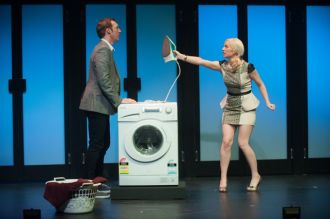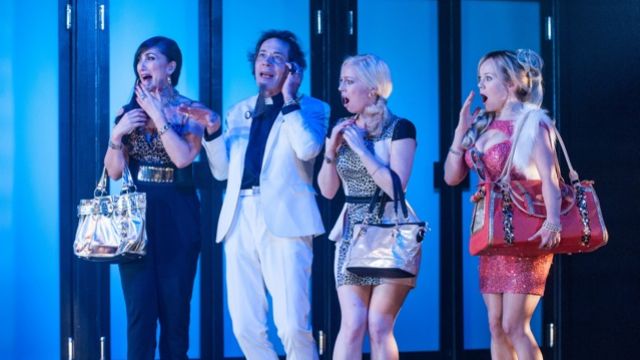No Room for Errors on Tour
You’ve got a cast of ten, a set full of doors, complex lights, and it all has to fit into a van as you tour to 32 wildly different venues across Australia. It sounds like a recipe for a comedy of errors. And as Frank Hatherley has discovered, this national tour of Shakespeare’s The Comedy of Errors turns day into night.
The Director
When rising young director Imara Savage was offered the daunting and exhilarating job of directing a tour of The Comedy of Errors she knew she had big problems to solve.
A co-production between Bell Shakespeare and the State Theatre Company of South Australia, the tour would open in Adelaide and run for five months, visiting 32 venues — from Townsville to Albany, from Hobart to Alice Springs — including seasons in major Sydney and Melbourne theatres.

Of course she said ‘yes!’ and her challenges began immediately. For instance, Savage tells me, “I found it an exceptionally difficult, very confusing play to read. Usually I have an inkling of what a play is about after the first reading, not necessarily where it’s set, but definitely an intuitive understanding of what it might be. The Comedy of Errors didn’t work like that for me.”
It may provide solace for students of the Bard that even the Bell Shakespeare’s 2011 director in residence initially finds Shakespeare hard to understand.
“Then I read it a couple more times and tried to figure out what that world of Ephesus [an ancient Greek port] was. Was it a place that I knew? Were these characters people I had met before? The comedy has to come from somewhere real. That was my real starting point.”
Eventually the penny dropped. “Oh, actually this place is somewhat familiar!” she remembers thinking. “This place has a lot of money — not old money, new money. How you present yourself — your clothes, your material possessions — are really important here. There’s neon lights and a lot of transactions going on, monetary and sexual transactions. It turned out to be round the corner from where I live in Sydney. It was Kings Cross.
“But not just Sydney’s Kings Cross. It feels more ephemeral than that. In any big metropolis there’s a place that never sleeps. In Amsterdam it’s the Red Light District.”
What came next? “Reading. I read a lot. I read about every production that has ever been done of the play, I read about Shakespeare at that time.” Then she collected images on the internet. “I’d go to Tumblr sites to collect references, and I’d go to YouTube and find people that I felt might be a little bit similar to the characters.”
Savage had also to confront the considerable budget and touring challenges. “It’s a play written for a cast of 14 — 12 minimum — and we have to do it with 10. In the final scene there are 12 characters on stage speaking. It was already complicated in terms of character exits and entrances. I remember thinking: quick changes!”

And then there was the challenge of developing an easily dismountable set. “The set has to tour in a van and it has to get in and out of 32 venues with very different-sized stages.”
How did she start the collaboration with her designer?
“I sent her a lot of emailed images – images of places, metropolises around the world, cities at night. And she said ‘oh, you’re not going to set it during the day!’. Then I realised that all the images I had sent her were of night, and I thought, yes, I think it has to happen at night.”
The events of Shakespeare’s play cover a single day from dawn till dusk. Savage had taken the major decision to set her production from dusk till dawn.
“At night things can happen, magic can happen, the world gets a bit surreal at night. I love the idea that you go out for the night with some friends and it just descends into madness. And at 6 o’clock in the morning the sun comes up and you all look at each other and you think: ‘Oh, god, what was that about? I should have gone home five hours ago’.
“From the beginning I really wanted neon on the set, with a whole lot of signage like you’d see in King’s Cross. People said it would be (a) too expensive and (b) totally untourable.” But, predictably, she wasn’t to be put off.
 The Set Designer
The Set Designer
Pip Runciman is an established set and costume designer for Theatre and Outdoor Events. Her brilliant set for the Sydney Theatre Company’s 2010 Our Town was a highlight of my recent theatre going. What was her first contact with director Savage on this project?
“I met with Imara and we discussed the play and we were both on a similar wavelength. I really liked her feel of the play’s world, a very dark world. I thought the references she sent me were great. Beautiful, strong images.”
But the limitations dominated her thinking. “If we had wanted to have a big flight of stairs or a balcony we would be limited to the space in the van. It’s normal for a set designer to have limitations. As well as being creative you need to be practical.”
The early concept design I am shown features a row of eight doorways, each with its own double swing doors. So who came up with the doors idea?
“I think we both did,” she says. “There were a lot of doorways in Imara’s references. And in my research on the play I discovered it had possibly been written [in 1594] for a night of revels by a London law school, and the hall where it was performed actually had five doors around the playing area. So, yes, we felt we wanted a lot of doors.
“We wanted a set that could be both ‘inside’ or ‘outside’ and could change very quickly from one to the other. We didn’t want clunky scene changes. There’s no fly tower in a lot of the venues so you can’t change things that way. And there’s no wing space in Sydney.”
Surprisingly, of the 32 venues, it’s the Playhouse Theatre at the Sydney Opera House, final venue of the tour for a four-week run in November/December, that has the most difficult stage of all. “It’s like a shelf with angled walls,” says Runciman. “There’s a door on one side and that’s about it.
“So we started with what would work in Sydney and moved out from there.”
We are talking after the first week of rehearsals. How is the cast coping with all the doors?
“I think they love them,” says Pip. “They’re enjoying the comic options the doors give them. It gives them the chance to do some Commedia dell’arte comedy work. I think the cast is going to have a blast.”
 Lighting Designer
Lighting Designer
Adelaide-based lighting man Mark Pennington is the third major creative partner. He works often with the State Theatre Company and the Adelaide Festival. He recently toured in Europe for three months lighting for the Australian Dance Theatre. “The entire lighting rig was ours. We didn’t use anything from the venues at all.”
“Imara’s concept of the play – shifting the action from being from dawn till dusk and making it from dusk till dawn – well, it’s a lighting designer’s gift. The day’s never particularly interesting to light; the night always is.”
What was the set like when you three first talked together about it?
“When I first saw the doors concept I was really surprised by the beautiful simplicity of it. They’ve developed a set that I think is really simple and yet allows itself to span a whole different range of spaces, can be dressed down and dressed up.”
So Pennington got to work on making the simple setting as versatile as possible.
“The set itself is now almost a giant lightbox. Conceptually, the set has become the main lighting source, almost like an installation. The predominant backlighting in the show will be colour-changing LED. The beauty of LED is that there’s no gel changes, they’re very low power usage and we tour our own lighting desk.
“I’ll be adding a couple of LED moving-head wash lights. They reduce the need for a massive front of house rig. Not only can they wash the stage with colour, but you can focus them right down to a spot as well. They rotate through 320 degrees, can tilt through 180 degrees, and they’re completely computer controlled. So, instead of being a massive thing with fans and gobos, the new ones allow you to colour-mix to any one of 1.7 million colours.”
I laugh at this mind-boggling number.
“That’s the claim anyway,” he says.
“We’ll have lots of time in Adelaide to pre-plot six or seven position groups on stage, and when we get on the road Daniel Voss, our young touring Head Electrician, will just need to update those six or seven things to match the venue and then the whole thing will fall into place.
“In some venues the show bumps in during the day and opens that night. So time’s really short. We issue a lighting plan in advance and they will pre-rig whatever we decide we can use out of their stock of lights. Then it’s Daniel’s job to plug our lighting desk in, add the stuff we tour with, and get the focus and the replot done before the show opens.”
 Pennington is something of an enthusiast for LEDs. “There were teething troubles to begin. But in the last five years the technology has advanced in extraordinary ways. They keep producing fixtures that use less power, that are brighter, and that colour-mix better.
Pennington is something of an enthusiast for LEDs. “There were teething troubles to begin. But in the last five years the technology has advanced in extraordinary ways. They keep producing fixtures that use less power, that are brighter, and that colour-mix better.
“Part of Imara and Pip’s concept of the show is around saturated colour. LED works so well with that. And they wanted lots of neon. The beauty of using LEDs is that we can have reds and blues and greens without having to go down the road of purchasing stuff that’s expensive and fragile.
“The doors all have frosted Perspex so from a lighting designer’s point of view they’re a bit of a gift. They’re a beautiful soft lightbox when they’re closed and you can get some lovely long shadows out of them when they’re open.”
With the many problems of the touring set and lighting in hand, Director Savage then turned her mind to the major challenge of the casting: Shakespeare’s play requires two sets of identical twins! When someone from Bell Shakespeare asked her how she planned to manage understudies on tour, her response was immediate. “I can’t think about that because my head will explode,” she replied.
The Comedy of Errors tour opened at the Dunstan Theatre, Adelaide on June 28.
Full tour dates - http://www.bellshakespeare.com.au/whatson/thecomedyoferrors
Production Photographer: Matt Netheimm.
Originally published in the July / August 2013 edition of Stage Whispers
Subscribe to our E-Newsletter, buy our latest print edition or find a Performing Arts book at Book Nook.

